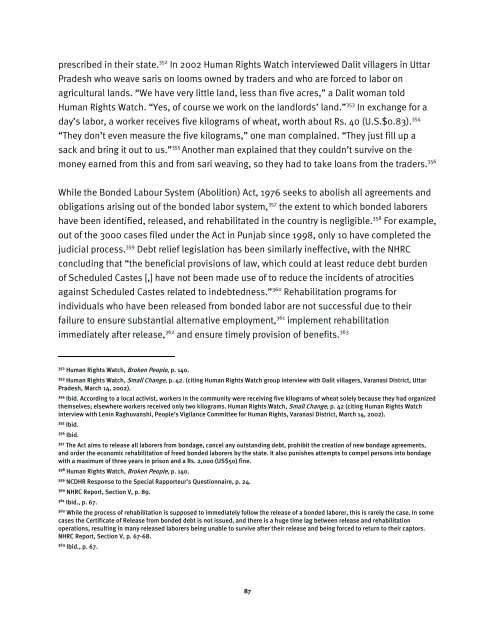Caste Discrimination against India's âUntouchablesâ - Human Rights ...
Caste Discrimination against India's âUntouchablesâ - Human Rights ...
Caste Discrimination against India's âUntouchablesâ - Human Rights ...
Create successful ePaper yourself
Turn your PDF publications into a flip-book with our unique Google optimized e-Paper software.
prescribed in their state. 352 In 2002 <strong>Human</strong> <strong>Rights</strong> Watch interviewed Dalit villagers in Uttar<br />
Pradesh who weave saris on looms owned by traders and who are forced to labor on<br />
agricultural lands. “We have very little land, less than five acres,” a Dalit woman told<br />
<strong>Human</strong> <strong>Rights</strong> Watch. “Yes, of course we work on the landlords’ land.” 353 In exchange for a<br />
day’s labor, a worker receives five kilograms of wheat, worth about Rs. 40 (U.S.$0.83). 354<br />
“They don’t even measure the five kilograms,” one man complained. “They just fill up a<br />
sack and bring it out to us.” 355 Another man explained that they couldn’t survive on the<br />
money earned from this and from sari weaving, so they had to take loans from the traders. 356<br />
While the Bonded Labour System (Abolition) Act, 1976 seeks to abolish all agreements and<br />
obligations arising out of the bonded labor system, 357 the extent to which bonded laborers<br />
have been identified, released, and rehabilitated in the country is negligible. 358 For example,<br />
out of the 3000 cases filed under the Act in Punjab since 1998, only 10 have completed the<br />
judicial process. 359 Debt relief legislation has been similarly ineffective, with the NHRC<br />
concluding that “the beneficial provisions of law, which could at least reduce debt burden<br />
of Scheduled <strong>Caste</strong>s [,] have not been made use of to reduce the incidents of atrocities<br />
<strong>against</strong> Scheduled <strong>Caste</strong>s related to indebtedness.” 360 Rehabilitation programs for<br />
individuals who have been released from bonded labor are not successful due to their<br />
failure to ensure substantial alternative employment, 361 implement rehabilitation<br />
immediately after release, 362 and ensure timely provision of benefits. 363<br />
352<br />
<strong>Human</strong> <strong>Rights</strong> Watch, Broken People, p. 140.<br />
353<br />
<strong>Human</strong> <strong>Rights</strong> Watch, Small Change, p. 42. (citing <strong>Human</strong> <strong>Rights</strong> Watch group interview with Dalit villagers, Varanasi District, Uttar<br />
Pradesh, March 14, 2002).<br />
354<br />
Ibid. According to a local activist, workers in the community were receiving five kilograms of wheat solely because they had organized<br />
themselves; elsewhere workers received only two kilograms. <strong>Human</strong> <strong>Rights</strong> Watch, Small Change, p. 42 (citing <strong>Human</strong> <strong>Rights</strong> Watch<br />
interview with Lenin Raghuvanshi, People’s Vigilance Committee for <strong>Human</strong> <strong>Rights</strong>, Varanasi District, March 14, 2002).<br />
355<br />
Ibid.<br />
356<br />
Ibid.<br />
357<br />
The Act aims to release all laborers from bondage, cancel any outstanding debt, prohibit the creation of new bondage agreements,<br />
and order the economic rehabilitation of freed bonded laborers by the state. It also punishes attempts to compel persons into bondage<br />
with a maximum of three years in prison and a Rs. 2,000 (US$50) fine.<br />
358<br />
<strong>Human</strong> <strong>Rights</strong> Watch, Broken People, p. 140.<br />
359<br />
NCDHR Response to the Special Rapporteur’s Questionnaire, p. 24.<br />
360<br />
NHRC Report, Section V, p. 89.<br />
361<br />
Ibid., p. 67.<br />
362<br />
While the process of rehabilitation is supposed to immediately follow the release of a bonded laborer, this is rarely the case. In some<br />
cases the Certificate of Release from bonded debt is not issued, and there is a huge time lag between release and rehabilitation<br />
operations, resulting in many released laborers being unable to survive after their release and being forced to return to their captors.<br />
NHRC Report, Section V, p. 67-68.<br />
363<br />
Ibid., p. 67.<br />
87

















